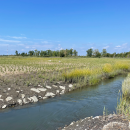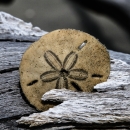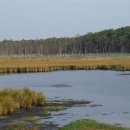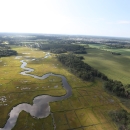The U.S. Fish and Wildlife Service, Cape May National Wildlife Refuge, manages property along the Delaware Bay including the Reeds Beach parcel. Reeds Beach includes a roughly 100-acre tidal marsh restoration area threatened by the effects of sea level rise, severe storms, and human intervention creating a stressed environment; which has led to marsh loss and conversion to open water, affecting the plant and wildlife in the area. As part of the U.S. Fish & Wildlife Service and Cape May NWR mission, the refuge began taking action in 2014 when it was awarded Hurricane Sandy Coastal Resiliency Program funding to reduce the growing risks from threats such as coastal storms, flooding, and erosion. Through this program funding, the USFWS and a contractor studied and designed a restoration plan for the 100 acre Reeds Beach parcel It wasconcluded that to best way to restore the ecosystem was to alleviate excess water from sitting on the surface of the marsh. Less water sitting on the marsh would allow the plants to become healthier which would allow the plant roots to hold and trap more sediment allowing the marsh to grow and keep up with sea level rise. The restoration at Reeds Beach began in 2017 when10,000 feet of runnels were created over 48 acres. Runnels are shallow excavations created in a sinuous way to mimic natural creeks and streams. The runnels were created to connect low lying areas to existing creeks using a ditcher mounted on an amphibious tracked vehicle called a Marsh Master that has extremely low ground pressure. The ditcher cuts into the soil and thinly spreads the removed soil over the marsh. In the fall of 2019, Cape May NWR launched the next phase of the Reeds Beach marsh restoration, by creating more runnels in the remaining52 acres in-house with a smaller USFWS Marsh Master. As the marsh soil is very soft and muddy, it is easy for one’s foot to sink 2-3 feet into the muck; leading to difficulty for the Marsh Master. Over 1,000 feet of runnels were created, though the smaller machine was not adequate for the weight of the ditcher, so the Cape May NWR staff went back to the drawing board. In the fall of 2020, Cape May NWR was able to dig the remaining 9,931 feet of runnels with the original larger Marsh Master, completing the construction phase in the Reeds Beach marsh . This final phase would not have been possible if not for funding that was provided by Ducks Unlimited, National Fish and Wildlife Foundation (NFWF), and the Friends of Cape May NWR. In previous years, the Friends of Cape May NWR financially supported refuge interns. This financial support was used as a matching source in order to obtain a National Fish and Wildlife Foundation grant. Cape May NWR believes that this habitat restoration will improve vegetation health and provide enhanced habitat for wildlife including American black duck, saltmarsh sparrow, diamondback terrapin, and many fish and shellfish. The Reeds Beach marsh unit will be monitored through the coming years to measure the success of the restoration project by looking at vegetation changes, marsh elevation changes, water level changes, and species abundance just to name a few. To date, low lying flooded formerly non-vegetated areas adjacent to runnels have begun to vegetate once again. This project is a great education opportunity for saltmarsh health, how marshes buffer the coast and communities from storms, sea level rise and marsh restoration work.
Habitat management, Monitoring, Research






